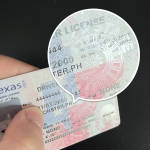In an age where security and accurate identification are of utmost importance, the concepts of Real ID and quantum – entanglement – based ID verification have emerged as significant topics. Real ID is a government – issued identification that adheres to certain minimum security standards. It aims to enhance the reliability and accuracy of identity documents used for various purposes, such as boarding commercial flights, accessing federal facilities, and other security – sensitive activities.
Currently, traditional Real ID systems rely on technologies like magnetic strips, barcodes, and chip – based systems. These have served well in many respects but also come with their own set of limitations. For example, magnetic strips can be easily cloned, and barcodes can be scanned surreptitiously. Chip – based systems, while more secure, are still vulnerable to certain forms of cyber – attacks.
Enter the realm of quantum entanglement. Quantum entanglement is a phenomenon in quantum mechanics where particles become linked in such a way that the state of one particle is instantaneously related to the state of another, regardless of the distance between them. This unique property has the potential to revolutionize ID verification.

Quantum – entanglement – based ID verification could work in the following way. When an individual presents their ID, the verification system would use quantum – entangled particles to create a unique and unbreakable link between the ID and the person. Any attempt to tamper with the ID or forge it would disrupt the quantum – entangled state, immediately alerting the verification system. This is because the act of measuring or interfering with one of the entangled particles instantaneously affects the other, a property that classical security systems lack.
The potential benefits of integrating quantum – entanglement – based verification into Real ID systems are numerous. First, it offers an unprecedented level of security. Since quantum entanglement is based on the fundamental laws of physics, it is extremely difficult, if not impossible, to hack or bypass. Second, it provides real – time verification. The instant nature of quantum entanglement allows for immediate confirmation of the authenticity of an ID, reducing waiting times at security checkpoints.
However, the implementation of quantum – entanglement – based ID verification is not without its challenges. One major hurdle is the complexity of quantum technology. Quantum systems require extremely precise control and are highly sensitive to environmental factors such as temperature and electromagnetic interference. Building and maintaining quantum – entanglement – based verification devices would require significant investment in research and development, as well as a highly skilled workforce.
Another challenge is the issue of scalability. Currently, quantum entanglement experiments are often conducted in highly controlled laboratory environments. Scaling up these technologies to a level where they can be used for mass – scale ID verification across the country or even globally is a significant engineering and logistical challenge.
Despite these challenges, researchers around the world are actively working on overcoming them. Many governments and private organizations are investing in quantum research, and significant progress has been made in recent years. For example, some quantum – entanglement – based communication systems have already been successfully demonstrated over long distances, which is a promising sign for the future of ID verification.
In the short – term, it is likely that traditional Real ID systems will continue to be the mainstay of identity verification. However, as quantum technology matures, we can expect to see the gradual integration of quantum – entanglement – based verification features. This could start with high – security applications such as government facilities and eventually expand to more general use cases like commercial transactions and everyday identity checks.
Moreover, the development of quantum – entanglement – based ID verification also has implications for international cooperation. As countries strive to enhance their security and identity verification systems, there will be a need for standardization and interoperability of quantum – based technologies. This could lead to new international agreements and collaborative research efforts.
When it comes to user – side considerations, education will play a crucial role. People need to be made aware of the new technology and how it works. They also need to be reassured about the security and privacy aspects. Since quantum – entanglement – based ID verification is based on a highly advanced and often – misunderstood field of physics, clear communication about its benefits and limitations will be essential to gain public trust.
Furthermore, privacy concerns are also an important aspect to address. While quantum – entanglement – based verification offers enhanced security, it is important to ensure that personal data is protected. Appropriate legal and regulatory frameworks need to be in place to govern the collection, storage, and use of identity – related information in the context of quantum – based systems.
Common Problems and Solutions
-
Problem: Lack of Understanding among the Public
Many people may not be familiar with the concept of quantum entanglement and how it can be used for ID verification. This lack of understanding can lead to resistance or mistrust of the new technology.Solution: Public Education Campaigns
Governments, technology companies, and educational institutions can collaborate to launch public education campaigns. These can include online resources, workshops, and awareness – raising events. The goal is to simplify the complex concepts of quantum entanglement and explain how it can enhance security in ID verification in an easy – to – understand manner. -
Problem: High Costs of Implementation
Developing and deploying quantum – entanglement – based ID verification systems can be extremely expensive. This includes the cost of research and development, building the necessary infrastructure, and training the workforce.Solution: Government and Private Sector Partnerships
Governments can partner with private technology companies to share the costs. For example, the government can provide funding for research, while private companies can contribute their technological expertise and resources for development and deployment. Additionally, economies of scale can be achieved as the technology becomes more widespread, reducing costs over time. -
Problem: Compatibility with Existing Systems
Integrating quantum – entanglement – based ID verification with existing Real ID systems may be a complex task. There may be issues with data format compatibility, communication protocols, and system architecture.Solution: Standardization and Interoperability Frameworks
International and national standards – setting bodies can work on developing standards for quantum – based ID verification. This will ensure that new quantum – entanglement – based systems can be easily integrated with existing ones. Interoperability frameworks can also be established to enable seamless communication between different systems. -
Problem: Environmental Sensitivity of Quantum Systems
Quantum systems are highly sensitive to environmental factors such as temperature, electromagnetic interference, and humidity. This can make it difficult to deploy them in real – world environments.Solution: Advanced Engineering and Shielding Technologies
Engineers can develop advanced shielding technologies to protect quantum systems from environmental interference. This may include using specialized materials and enclosures to isolate the quantum components. Additionally, environmental monitoring and control systems can be integrated to maintain optimal conditions for the quantum – entanglement – based verification devices. -
Problem: Privacy Concerns
With the use of advanced technology for ID verification, there are concerns about how personal data will be protected. There is a fear that quantum – based systems may be more vulnerable to data breaches or misuse of personal information.Solution: Robust Legal and Regulatory Frameworks
Governments need to establish comprehensive legal and regulatory frameworks for quantum – entanglement – based ID verification. These should cover aspects such as data collection, storage, access, and sharing. Strong penalties should be in place for any violations of privacy rights. Additionally, privacy – by – design principles should be incorporated into the development of quantum – based ID verification systems to ensure that privacy is protected from the start.
Fake ID Pricing
unit price: $109
| Order Quantity | Price Per Card |
|---|---|
| 2-3 | $89 |
| 4-9 | $69 |
| 10+ | $66 |



